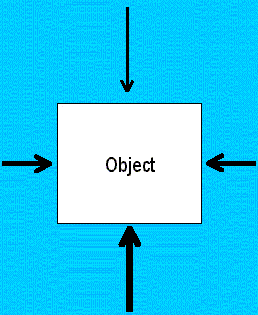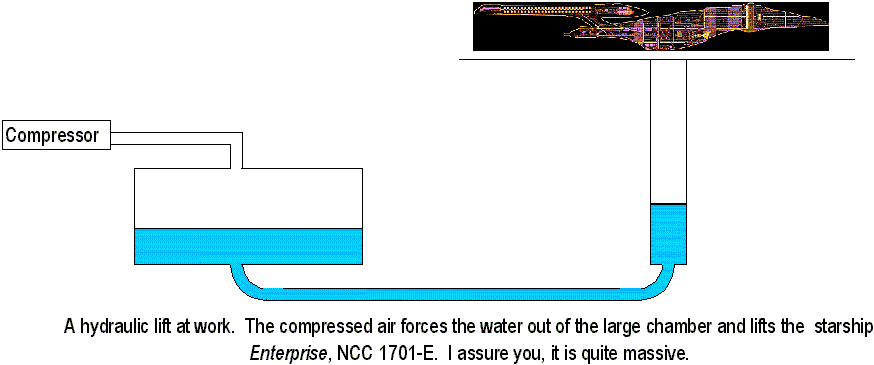
 Location: Ch 8: Liquids
Location: Ch 8: Liquids

 Location: Ch 8: Liquids
Location: Ch 8: Liquids
|
 |
PROPERTIES OF MATTER
IN THIS CHAPTER:
|
 he liquid phase is the state of matter where molecules can
flow freely by sliding over each other. Since liquids take the shape of
their containers, the liquid exerts forces on the walls and bottom of the
container. Pressure describes the interaction between the weight of the
block against the area of contact. Thus,
he liquid phase is the state of matter where molecules can
flow freely by sliding over each other. Since liquids take the shape of
their containers, the liquid exerts forces on the walls and bottom of the
container. Pressure describes the interaction between the weight of the
block against the area of contact. Thus,  Scientists
more often use kilopascals (kPa) because a pascal itself is very small.
A liquidís weight depends on its density. It turns out that the pressure
of a liquid at rest depends only on the density and depth of the liquid,
not on the shape of the container or the size of its bottom surface. The
pressure of a liquid can be calculated with this formula: Pressure =
weight density ´ depth. However, the
above formula only works if the liquid is in a airtight container that
contains no air. Thus, Total pressure = weight density
´ depth + pressure of the atmosphere.
Therefore, at any given depth, a liquid always exerts the same pressure against any surface, whether it be the bottom or the sides of a container, or a submerged object. It does not matter how much liquid there is in the container; pressure only depends on the depth of the water. At any point within a liquid, the forces that produce pressure are exerted in every direction. If the container holding the liquid has holes in it, then the water will shoot out of the container on a path perpendicular to the surface.
Scientists
more often use kilopascals (kPa) because a pascal itself is very small.
A liquidís weight depends on its density. It turns out that the pressure
of a liquid at rest depends only on the density and depth of the liquid,
not on the shape of the container or the size of its bottom surface. The
pressure of a liquid can be calculated with this formula: Pressure =
weight density ´ depth. However, the
above formula only works if the liquid is in a airtight container that
contains no air. Thus, Total pressure = weight density
´ depth + pressure of the atmosphere.
Therefore, at any given depth, a liquid always exerts the same pressure against any surface, whether it be the bottom or the sides of a container, or a submerged object. It does not matter how much liquid there is in the container; pressure only depends on the depth of the water. At any point within a liquid, the forces that produce pressure are exerted in every direction. If the container holding the liquid has holes in it, then the water will shoot out of the container on a path perpendicular to the surface.
When objects are submerged in water, the apparent loss
of weight actually results from buoyancy. Buoyancy re sults
from water exerting an upward force on an object. This upward force is
known as the buoyant force. Since the forces that act on the sides of a
submerged object are equal, they cancel each other out. However, the forces
that act on the top and bottom of the object are not equal. The bottom
force is greater than the top force and thus it appears as though the object
loses weight. Buoyant force can be calculated with this formula: Bottom
force Ė upper force. If the weight of a submerged object is greater
than the buoyant force, it sinks. If they are equal then the object will
remain at its current level. If the buoyant force is greater than the weight
of the object, it will be pushed to the top where it will float. If a stone
is placed in a container of water, the volume of the water displaced is
equal to the volume of the stone. Since a completely submerged object always
displaces a volume of fluid equal to its own volume, that is a good way to measure the volume of an irregular shaped object.
sults
from water exerting an upward force on an object. This upward force is
known as the buoyant force. Since the forces that act on the sides of a
submerged object are equal, they cancel each other out. However, the forces
that act on the top and bottom of the object are not equal. The bottom
force is greater than the top force and thus it appears as though the object
loses weight. Buoyant force can be calculated with this formula: Bottom
force Ė upper force. If the weight of a submerged object is greater
than the buoyant force, it sinks. If they are equal then the object will
remain at its current level. If the buoyant force is greater than the weight
of the object, it will be pushed to the top where it will float. If a stone
is placed in a container of water, the volume of the water displaced is
equal to the volume of the stone. Since a completely submerged object always
displaces a volume of fluid equal to its own volume, that is a good way to measure the volume of an irregular shaped object.
The Greek philosopher Archimedes discovered the relationship between buoyancy and displaced liquid in 3 BC. Archimedesí principle states that any immersed object is buoyed up by a force equal to the weight of the fluid it displaces. Thus, if we submerge a 3N brick into a full pitcher of water, and discover that it displaced 2N of water, then the brick should be buoyed up by a force of 2N and appear to weight only 1N. The depth of the stone does not make a difference; only the difference between the top and bottom forces on the object. If the object floats, then the principle of floatation applies. This principle states, "A floating object displaces a weight of fluid equal to its own weight." Thus, a 10,000 ton ship must displace 10,000 tons of water or it will sink.
Whether or not an object floats is dependent on how great
the buoyant force is compared with the objectís weight. If an object floats,
then the volumes of the object and the displaced water must be equal, and
so are the densities of the two. Therefore, whether or not an object floats
can be summarized into the following three rules:
|

